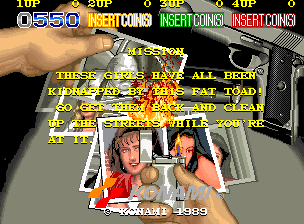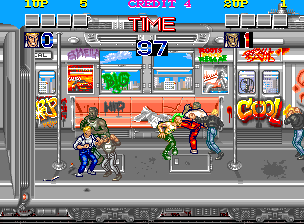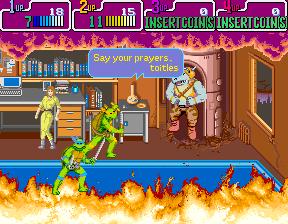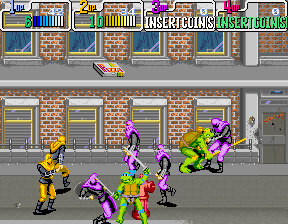
1989: Beat-em-ups
originally written December 17, 2009 / Last edited August 7, 2023
1987's Double Dragon was a huge arcade senstion that completely redefined the beat-em-up genre that many say IREM's Kung-Fu Master started in 1984. Nekketsu Koha Kunio-kun (a.k.a. Renegade) may have arrived one year earlier, but Double Dragon's refinements on those play mechanics were more like stone tablets enscribed with brawler commandments, carried down from the mountain by a denim-vested diety who smote the wicked with aluminum baseball bats and booted feet. Everything from its two-player simultaneous gameplay, isometric playfield, control scheme, fighting options, detailed graphics and designs of the characters themselves are what truly set the standard for most of the beat-em-ups that followed. Technos raised the bar rather high and their competitors either made earnest attempts to rise to the challenge or made shameless rip-offs that fell flat. Sure, we got some fun games like Bad Dudes vs. Dragonninja, but the next evolution of the Beat 'Em Up wouldn't happen until 1989.

Besides the classic "hero saves girl from gang" storyline (though this game has players rescuing a jail cell full of kidnapped beauties), this game doesn't play like a complete Double Dragon rip, something that can't be said for many BEU games from 1987 to 1989. Like many of Konami's later arcade side-scrollers, the main version of this game allows four players to play at once, a set-up also seen in their 1988 wrestling game, The Main Event. The graphical style still resembles their earlier side-scrollers like Jail Break and Rush 'n Attack (a.k.a. Green Beret), but with hints of the detail that would make Konami's later games a wonder to see in action. If you're a fan of Konami's brawlers, you'll find a few of your favorite things in here including the ability to attack fallen enemies before they get back up, driving a kneecap into the sensitive area of the bad guys (complete with the sound of a fight bell being rung), and blunt weapons or boss attacks knocking victims into the background's walls. Many of the bosses make some fun first impressions, like the gas-guzzling biker you see over there. This is also one of the early Konami games to feature backgrounds that threaten to steal the show. More than just being something to fill space behind the beatdowns, these background contain advertisements that take on a life of their own, hazards that can produce cartoon-like effects if they hit you and much more detail many stages that you'll find from this time period.
The game may be a bit rough around the edges, as issues with attack timing, attack range and other issues never let the game play completely gel enough to be a classic, such issues are the price of innovation when game creators are trying to do more than just copy the latest proven hit of the genre. In a May 2023 Time Extension interview, Crime Fighter designer/director/artist Masaaki Kukino reveals what many of us beat 'em up fans suspect all along, that this game was the blueprint for a classic that would debut in the same year...

By 1989, Turtle Power had built up a full head of steam. The Murakami-Wolf cartoon had become an essential part of the afternoon cartoon schedule and the Playmates toy line was selling well enough to elbow a decent amount of room in the toy aisles alongside robots in disguise and real American heroes. Though I had read the Eastman & Laird comic first, I dug both the toys and cartoon and didn't have the nerdrage/hissy fit that some comic fans threw. That's why I can still remember the time that I walked into the Eastwood Mall and swore I heard the Ninja Turtles theme song echoing through a large hallway in the front. But where was it coming from? Was some store playing a tape to promote the toys? Man, why didn't they do that for G.I. JOE or Transformers? No, wait... it was coming from the arcade! As I walked a little faster than usual through the entrance, I was surprised by the sight of a four-player Teenage Mutant Ninja Turtles game that was playing the real theme song. If you don't understand why that was such a shock, fire up MAME, sort the games by year and have fun finding a game that sings a recognizable theme song as visuals close to a show's intro plays on the giant screen of a four-player arcade game. Once you've finished doing that, please come back and tell the rest of the class about the time you found jack squat. My friend, I tell you, this was a big deal in 1989 and that was before you even put money into the machine. It's proof of how much Konami knew their games needed to blow potential players minds in the middle of arcades filled with other machines trying like hell to out-bleep each other. In fact, from the moment you see and hear the machine until you defeat the last enemy, you are essentially playing the cartoon. No game before it, not even Nintendo's excellent Popeye, felt as much like playing the cartoon. The entire game is one huge mark-out moment for fans of the animated Ninja Turtles.
All of this effort would have been for nothing if the game wasn't such an accessible game to play. The controls are simple but cover a wide range of options and can be easily figured out in a few moments with the only learning curve being the jumpkick methods, picking up on the attack patterns and paying attention to the stage. The fighting does owe a bit to Double Dragon's more contextual method of fighting, in which the position of your character compared to your opponent or where you are in the jump determines the move when you press attack. It was a blast to play this game with three other people in the arcade because you rarely had to worry if the player knew how to play or if they'd accidentally beat the crap out of you and cost you a life. Just like Crime Fighters, there are little interactions with the background that can work against you and some that will help you fight the enemy in a way that the Turtles would do in the show. This game had the total package and went far beyond your usual tie-in game by being a great game in its own right. The popularity of the Turtles led to the popularity of the game, which made beat-em-ups even more popular. It's a shame that few companies would put forth as much effort as Konami did, as many of their competitors simply used licenses to trick people into wasting money on rushed, poorly-made games. Fortunately, one of the few companies to match these efforts of fully utilizing a license with great, accessible play mechanics just happens to be another company that made a 1989 beat-em-up that helped mold the beat-em-up genre forever or else I wouldn't have been able to make this strained segue-way...
Return to top of the top of the page






